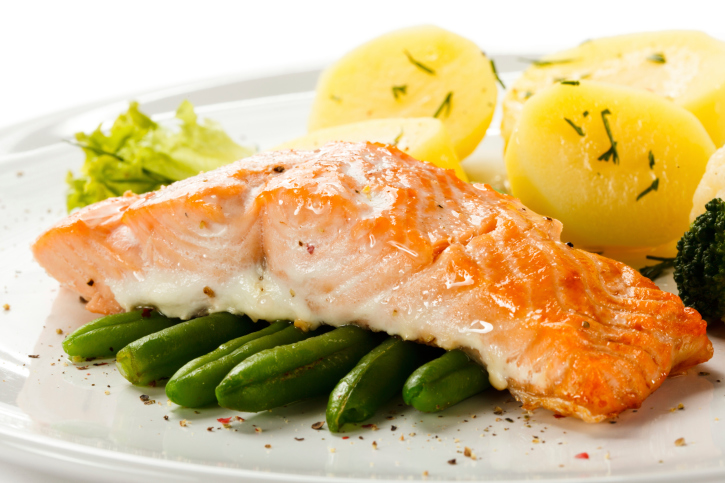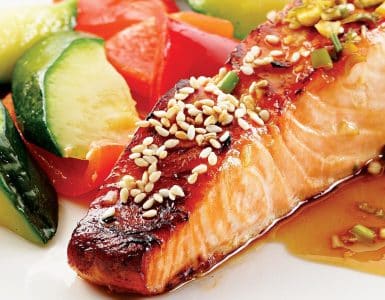Eating fish provides you with heart- and brain-healthy omega 3 fatty acids. Fish is also low in fat and an excellent source of lean protein. But did you know that not all fish may be good for your health?
Seafood is consumed all over the world, and most countries have a seafood industry. Trying to keep up with consumption and competitors may result in less than desirable harvesting and farming practices as well as overfishing. At the same time, fish that are higher up on the food chain contain greater levels of mercury and toxins due to eating other fish. Making smart choices when selecting fish can contribute to your health and also protect the environment.
Benefits of Eating Fish
The benefits of eating fish are attributed to seafood’s high amounts of omega 3 fatty acids. In fact, fish are one of the best sources of omega 3s. Your body can’t produce this healthy fat on its own, but it is necessary for a variety of bodily functions. Omega 3s may protect your heart and cardiovascular system, reduce inflammation, prevent depression, maintain cognitive functioning and assist with your neurological system.
How Much Fish Should You Eat?
The United States Department of Agriculture recommends eating a minimum of two 3-ounce servings of fish in a week. A 3-ounce portion of fish is equal to the size of a checkbook.
Healthiest Fish to Eat*
Abalone
Albacore tuna (canned, caught in the US or Canada)
Alaskan salmon
Atlantic mackerel
Anchovies
Farmed Arctic char
Farmed and US-caught striped bass
Farmed scallops
Catfish (US-caught)
Clams, mussels and oysters
Coho salmon
Mahi Mahi (US-caught)
Pacific cod (US-caught)
Lobster (US, Bahamian or Mexican-caught)
Shrimp (Alaskan wild or US-farmed)
Snapper (US-caught)
Squid (US-caught)
Rainbow Trout (US or Ecuador-caught)
Black or red grouper (US-caught)
Fish to Avoid*
Imported abalone, catfish, cod, crab, lobster, Mahi Mahi, shrimp, squid, swordfish
U.S Atlantic Skate
Tilefish
Orange roughy
Farmed salmon
Farmed eel
Bluefin tuna
Chilean sea bass
Farmed tilapia
Shark
Tips for Eating Healthy and Sustainable Fish
- Check the label. Key things to look for include country of origin. US-caught fish is usually healthier than imported fish because there are stricter standards in the United States than in most other countries.
- Watch for organic products. Seafood products labeled “organic” are always farm-raised. For the majority of fish this is okay, but it is recommended to stay away from farmed salmon, eel and tilapia.
- Follow this general rule to avoid fish high in mercury: Eat lower on the food chain, as the smaller the fish, the smaller amount of mercury. Fish that eat other fish have higher mercury counts.
- Expand your palate. Seafood can be a great addition to sandwiches, salads and tacos rather than the usual protein standbys of beef and poultry.
- Eat more shellfish. Shellfish such as oysters, mussels and clams all have high amounts of healthy omega 3s.
- Don’t be afraid of frozen seafood. Seafood freezes well, and frozen options can be just as healthy, if not healthier, than fresh. Freezing fish preserves much of the nutrition, depending on the length of time the fresh fish had been caught and then prepared for sale.
- Go for cans or pouches. Don’t be afraid of eating seafood that comes in cans or pouches. Tuna, salmon and sardines are commonly found in cans and pouches. This is a simple way to make seafood more accessible and easy to prepare.
- Avoid the fryer. Frying seafood increases its fat and calories, and may compromise the seafood’s nutritional value due to high heat. Opt for grilling, broiling, baking or roasting fish.
- Use proper cook times to ensure food safety. Fish should be cooked to 145 degrees and should flake with a fork when done. Shrimp, lobster and scallops will have a milky white color when they are cooked. Oysters, mussels and clams should open to indicate they are done cooking.
Healthy Seafood Recipe Roundup
Need nutritious seafood recipes? Check out these links!
A Variety of Seafood Recipes:
http://www.seafoodwatch.org/consumers/sustainable-recipes
http://www.eatingwell.com/recipes_menus/collections/healthy_seafood_recipes
Seafood Soup Recipes:
http://www.eatingwell.com/recipes_menus/collections/healthy_seafood_soup_recipes
Seafood Pasta Recipes:
http://www.eatingwell.com/recipes_menus/collections/healthy_seafood_pasta_recipes
Seafood Salad Recipes:
http://www.eatingwell.com/recipes_menus/collections/healthy_seafood_salad_recipes
For Health Advocate Members
Are you looking for more information on healthy seafood? If you are a Health Advocate member with access to our Wellness Program, connect with a Wellness Coach for additional tips and recipes.
*Source: Monterey Bay Aquarium



